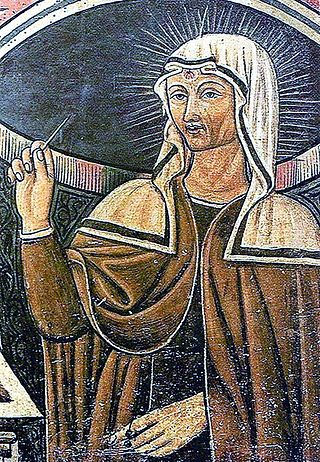
Rita of Cascia, OSA, was an Italian widow and Augustinian nun. After Rita's husband died, she joined a small community of nuns, who later became Augustinians, where she was known both for practicing mortification of the flesh and for the efficacy of her prayers. Various miracles are attributed to her intercession, and she is often portrayed with a bleeding wound on her forehead, which is understood to indicate a partial stigmata.

Carmela Soprano, played by Edie Falco, is a fictional character on the HBO TV series The Sopranos. She is married to Mafia boss Tony Soprano. A young Carmela, portrayed by Lauren DiMario, appears in the 2021 prequel film, The Many Saints of Newark. She's known for her strength, intelligence, and conflicted feelings about her marriage and lifestyle.

The Feast of San Gennaro, also known as San Gennaro Festival, is a Neapolitan and Italian-American patronal festival dedicated to Saint Januarius, patron saint of Naples and Little Italy, New York.
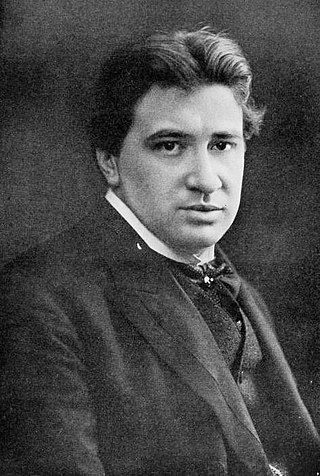
I gioielli della Madonna is a opera in three acts by Ermanno Wolf-Ferrari to an Italian libretto by Carlo Zangarini and Enrico Golisciani, based on news accounts of a real event. First performed in 1911, the opera's controversial themes include love between a brother and his adoptive sister, implied criticism of the Catholic Church, and an on-stage orgy.
Benedetta Carlini was an Italian Catholic nun who claimed to experience mystic visions. As abbess of the Convent of the Mother of God, at Pescia, she had a sexual relationship with one of her nuns, Sister Bartolomea. These came to the attention of the Counter-Reformation papacy, determined to subordinate potentially troublesome mystics if they showed any signs of heretical spirituality. Although they paid three to four visits to the nunnery, it was not until they interrogated Sister Bartolomea that they found that Benedetta and Bartolemea had engaged in sexual relations. Bartolomea gave testimony that Benedetta engaged in frottage with her while possessed by the spirit of a male demon known as Splenditello. Benedetta was stripped of her rank and imprisoned.
"The Ride" is the 74th episode of the HBO original series The Sopranos and the ninth of the show's sixth season. Written by Terence Winter and directed by Alan Taylor, it originally aired on May 7, 2006.
Victor Michael Milenski founded the Long Beach Opera in 1979, and was its general director for 25 seasons, retiring in 2004. Though local opera companies had been organized in the 1920s and 1960s in metropolitan Los Angeles, under Milenski’s direction the Long Beach Opera became the first professional opera company to take root in the modern era and survive. Having predated the formation of Los Angeles Opera and Orange County's Opera Pacific, Long Beach Opera is the Los Angeles area's oldest standing professional opera company.
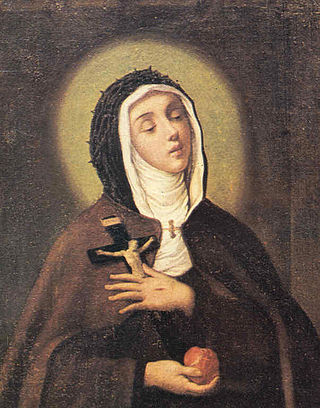
Veronica Giuliani, OSC Cap. was an Italian Capuchin Poor Clares nun and mystic. She was canonized by Pope Gregory XVI in 1839.

Catherine Malfitano is an American operatic soprano and opera director. Malfitano was born in New York City, the daughter of a ballet dancer mother, Maria Maslova, and a violinist father, Joseph Malfitano. She attended the High School of Music and Art and studied at the Frank Corsaro Studio and Manhattan School of Music, graduating in 1971. She often mentions that she was rejected from The Juilliard School.
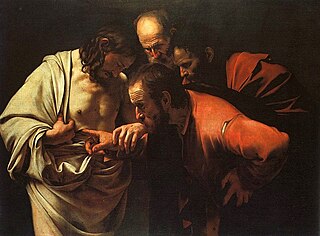
A number of people have claimed to have had visions of Jesus Christ and personal conversations with him. Some people make similar claims regarding his mother, Mary. Discussions about the authenticity of these visions have often invited controversy. The Catholic Church endorses a fraction of these claims, and various visionaries it accepts have achieved beatification, or even sainthood.
Rosemary Kuhlmann was an American operatic mezzo-soprano and Broadway musical actress best known for originating the role of the Mother in Gian Carlo Menotti's Amahl and the Night Visitors, the first opera commissioned for television. Kuhlmann portrayed the role on the annual live NBC broadcast of the production from 1951 through 1962.
Bleecker Street is a street in Greenwich Village, New York City.
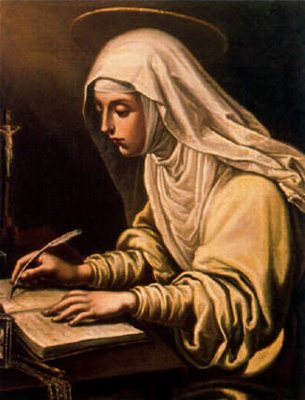
Catherine de' Ricci, OP, was an Italian Catholic nun in the Third Order of St. Dominic. She is believed to have had miraculous visions and corporeal encounters with Jesus Christ. She is also said to have spontaneously bled with the wounds of the crucified Christ. She is venerated for her mystic visions and is venerated as a saint by the Catholic Church.

The Last Savage is an opera in three acts by composer Gian Carlo Menotti. Menotti wrote his own libretto, originally in the Italian language. The opera was translated into French by Jean-Pierre Marty for the work's first (private) performance at the Opéra-Comique in Paris on 21 October 1963, followed the next day by the public premiere. George Mead translated the work into English for the opera's American premiere at the Metropolitan Opera the following year.
Maria di Gerlando was an American operatic soprano and voice teacher who was a leading performer at the New York City Opera from 1953 to 1969. She was best known for creating the role of Carmela in the 1954 world premiere of Gian Carlo Menotti's The Saint of Bleecker Street.
Gloria Lane Krachmalnick was an American operatic mezzo-soprano who had an active international performance career from 1949 to 1976. In her early career she distinguished herself by creating roles in the world premieres of two operas by Gian Carlo Menotti, the Secretary of the Consulate in The Consul (1950) and Desideria in The Saint of Bleecker Street (1954); both roles which she performed in successful runs on Broadway and on international tours. For her performance in The Consul she was awarded a Clarence Derwent Award and two Donaldson Awards.

Elena Aiello was an Italian religious sister and the founder of the Minim Sisters of the Passion of Our Lord Jesus Christ. Aiello joined the Sisters of the Most Precious Blood but was forced to leave due to grave health that soon kept her confined to her home where she began experiencing visions of both Jesus Christ and the Madonna as well as saints such as Francis of Paola. Her beatification was celebrated on 14 September 2011.

Gian Carlo Menotti was an Italian-American composer, librettist, director, and playwright who is primarily known for his output of 25 operas. Although he often referred to himself as an American composer, he kept his Italian citizenship. One of the most frequently performed opera composers of the 20th century, he wrote his most successful works in the 1940s and 1950s. Highly influenced by Giacomo Puccini and Modest Mussorgsky, Menotti further developed the verismo tradition of opera in the post-World War II era. Rejecting atonality and the aesthetic of the Second Viennese School, Menotti's music is characterized by expressive lyricism which carefully sets language to natural rhythms in ways that highlight textual meaning and underscore dramatic intent.

Edvige Carboni was an Italian Roman Catholic from Sardinia who relocated to Rome and became well known among the faithful and religious alike for her ecstasies and angelic visions. She recorded an extensive spiritual journal in which she recorded appearances from Jesus Christ as well as saints such as Gemma Galgani and John Bosco. Carboni was said to have experienced demonic experiences and stigmata.

The Most Important Man is an opera in three acts with music and libretto by Gian Carlo Menotti. Commissioned by Julius Rudel for the New York City Opera, the work premiered at Lincoln Center in 1971 in a production directed by Menotti with sets designed by Oliver Smith and costumes by Frank Thompson. An opera focusing on racial tensions in Africa with a central black hero, the work was poorly received by most critics. However, Menotti personally believed that this was one of his best operas on par with The Consul and The Saint of Bleecker Street. The work's first European performance was at the Teatro Lirico Giuseppe Verdi in Trieste, Italy, on January 17, 1972. The opera uses Menotti's characteristic lyrical style which is inspired by Puccini and the Italian verismo opera tradition. In this work he infuses African percussion and rhythms, much in the way Puccini infused Asian inspired melodies and musical practices into his opera Madama Butterfly.












